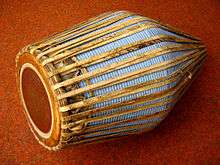Khol
|
Mridanga bayan | |
| Classification | Avandhha Vadya |
|---|---|

The khol (Bengali: খোল, Assamese: খোল) also known as a mrdanga in the Odia language (lit. "mrit+anga" = "clay limb") or mridôngo (Bengali: মৃদঙ্গ) (not to be confused with mridangam) is a terracotta two-sided drum used in northern and eastern India for accompaniment with devotional music (bhakti). It originates from the Indian states of West Bengal, Assam and Manipur. The drum is played with palms and fingers of both hands.
Construction

The khol is a drum with a hollow earthen body, with drumheads at both ends, one far smaller than the other. The drumheads are made of cow skin, and are three-layered and treated with a circle of rice paste, glue, and iron known as syahi. Some modern instruments are made with a fibreglass body and synthetic drumheads.
History
There are so many histories about its origin. Different types of Khol are available in north eastern India. Manipur, Bengal and Assamese Khol are commomly found in different forms. The khol was used by the Assamese saint Sankardev.[1]
Use
The drum is used to accompany Bengali, Oriya kirtans by medieval poets like Chandidas, Govindadasa and Gyanadas. It is also used to accompany Gaudiya Nritya, one of the nine Indian classical dances (as recognized by Ministry of Culture, and not recognized by Sangeet Natak Akademi).
In the International Society for Krishna Consciousness (ISKCON, "Hare Krishnas") and in Gaudiya Vaishnava societies, the khol is the primary drum for bhajan and kirtan.
See also
References
- ↑ Indian Literature. Sähitya Akademi. 1970. p. 84. Retrieved 23 December 2012.
External links
| Wikimedia Commons has media related to Mridanga. |

